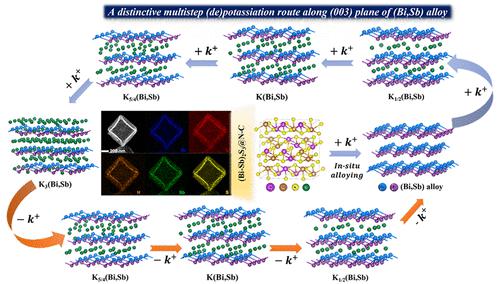Our official English website, www.x-mol.net, welcomes your
feedback! (Note: you will need to create a separate account there.)
Understanding the Highly Reversible Potassium Storage of Hollow Ternary (Bi-Sb)2S3@N-C Nanocube
ACS Nano ( IF 15.8 ) Pub Date : 2023-03-21 , DOI: 10.1021/acsnano.2c12703 Liping Yang 1, 2 , Lu Guo 3 , Dong Yan 4 , Ye Wang 5 , Ting Shen 2 , Dong-Sheng Li 6 , Mei Er Pam 2 , Yumeng Shi 1 , Hui Ying Yang 2
ACS Nano ( IF 15.8 ) Pub Date : 2023-03-21 , DOI: 10.1021/acsnano.2c12703 Liping Yang 1, 2 , Lu Guo 3 , Dong Yan 4 , Ye Wang 5 , Ting Shen 2 , Dong-Sheng Li 6 , Mei Er Pam 2 , Yumeng Shi 1 , Hui Ying Yang 2
Affiliation

|
Metal sulfide anodes have aroused much attention in potassium ion batteries (PIBs) owing to their high theoretical capacities, but the sluggish kinetics and inferior cycling performance caused by severe volumetric change and particle pulverization greatly hinder their further development. Herein, robust hollow structure design together with phase structure engineering endow (Bi-Sb)2S3@N-C anode with superior (de)potassiation kinetics and excellent electrochemical performances in PIBs. Specifically, in situ X-ray diffraction combined with density functional theory calculations and ex situ X-ray photoelectron spectroscopy and high-resolution transmission electron microscopy (TEM) analyses indicated a fresh reaction mechanism of (Bi-Sb)2S3 anode with a distinctive multistep (de)potassiation route along (003) plane of (Bi,Sb) alloy thanks to the Bi-Sb phase regulation in (Bi-Sb)2S3 anode, ensuring it with superior reaction kinetics. Moreover, in situ TEM characterization revealed the advantages of the hollow nanostructure with carbon shell, facilitating fast ion transport kinetics and high tolerance of volume change as well as enabling the structural integrity of electrode material during (de)potassiation. As a result, the (Bi-Sb)2S3 hollow nanocube with N-doped carbon shell ((Bi-Sb)2S3@N-C) delivers a high initial Coulombic efficiency of 66.3%, a great rate performance of 289 mAh g–1 at 2.0 A g–1, and an ultralong cycling life (89% retention after 220 cycles at 0.1 A g–1 and 85% retention after 1600 cycles at 2.0 A g–1) in PIBs. Furthermore, the full cell of (Bi-Sb)2S3@N-C//PTCDA affords a high reversible capacity of 281 mA h g–1 at 1.0 A g–1 after 300 cycles. This work combines structural design and in situ techniques, proving a successful nanostructure engineering strategy to rationalize alloy-type electrode materials for PIBs.
中文翻译:

了解空心三元 (Bi-Sb)2S3@NC 纳米立方体的高度可逆钾存储
金属硫化物负极由于其高理论容量而在钾离子电池(PIB)中引起了广泛关注,但严重的体积变化和颗粒粉碎导致的动力学缓慢和循环性能差极大地阻碍了其进一步发展。在此,稳健的中空结构设计与相结构工程赋予 (Bi-Sb) 2 S 3 @NC 阳极在 PIB 中具有优异的(去)钾化动力学和优异的电化学性能。具体而言,原位X 射线衍射结合密度泛函理论计算和非原位X 射线光电子能谱和高分辨率透射电子显微镜 (TEM) 分析表明 (Bi-Sb) 的新反应机制由于 (Bi-Sb) 2 S 3阳极中的 Bi-Sb 相调节, 2 S 3阳极沿 (Bi,Sb) 合金的 (003) 平面具有独特的多步(去)钾化路线,确保其具有出色的反应动力学. 此外,原位TEM 表征揭示了具有碳壳的中空纳米结构的优势,促进了快速离子传输动力学和对体积变化的高耐受性,以及在(去)钾化过程中实现电极材料的结构完整性。结果,具有N掺杂碳壳的(Bi-Sb) 2 S 3中空纳米立方体((Bi-Sb) 2 S 3@NC) 提供了 66.3% 的高初始库仑效率,在 2.0 A g –1时具有 289 mAh g –1的出色倍率性能,以及超长的循环寿命(在 0.1 A g –1和 85下 220 次循环后保持 89% PIB 中2.0 A g –1 ) 1600 次循环后的保留百分比。此外,(Bi-Sb) 2 S 3 @NC//PTCDA全电池在 1.0 A g –1循环 300 次后可提供 281 mA hg –1的高可逆容量。这项工作结合了结构设计和原位技术,证明了一种成功的纳米结构工程策略,使 PIB 的合金型电极材料合理化。
更新日期:2023-03-21
中文翻译:

了解空心三元 (Bi-Sb)2S3@NC 纳米立方体的高度可逆钾存储
金属硫化物负极由于其高理论容量而在钾离子电池(PIB)中引起了广泛关注,但严重的体积变化和颗粒粉碎导致的动力学缓慢和循环性能差极大地阻碍了其进一步发展。在此,稳健的中空结构设计与相结构工程赋予 (Bi-Sb) 2 S 3 @NC 阳极在 PIB 中具有优异的(去)钾化动力学和优异的电化学性能。具体而言,原位X 射线衍射结合密度泛函理论计算和非原位X 射线光电子能谱和高分辨率透射电子显微镜 (TEM) 分析表明 (Bi-Sb) 的新反应机制由于 (Bi-Sb) 2 S 3阳极中的 Bi-Sb 相调节, 2 S 3阳极沿 (Bi,Sb) 合金的 (003) 平面具有独特的多步(去)钾化路线,确保其具有出色的反应动力学. 此外,原位TEM 表征揭示了具有碳壳的中空纳米结构的优势,促进了快速离子传输动力学和对体积变化的高耐受性,以及在(去)钾化过程中实现电极材料的结构完整性。结果,具有N掺杂碳壳的(Bi-Sb) 2 S 3中空纳米立方体((Bi-Sb) 2 S 3@NC) 提供了 66.3% 的高初始库仑效率,在 2.0 A g –1时具有 289 mAh g –1的出色倍率性能,以及超长的循环寿命(在 0.1 A g –1和 85下 220 次循环后保持 89% PIB 中2.0 A g –1 ) 1600 次循环后的保留百分比。此外,(Bi-Sb) 2 S 3 @NC//PTCDA全电池在 1.0 A g –1循环 300 次后可提供 281 mA hg –1的高可逆容量。这项工作结合了结构设计和原位技术,证明了一种成功的纳米结构工程策略,使 PIB 的合金型电极材料合理化。









































 京公网安备 11010802027423号
京公网安备 11010802027423号